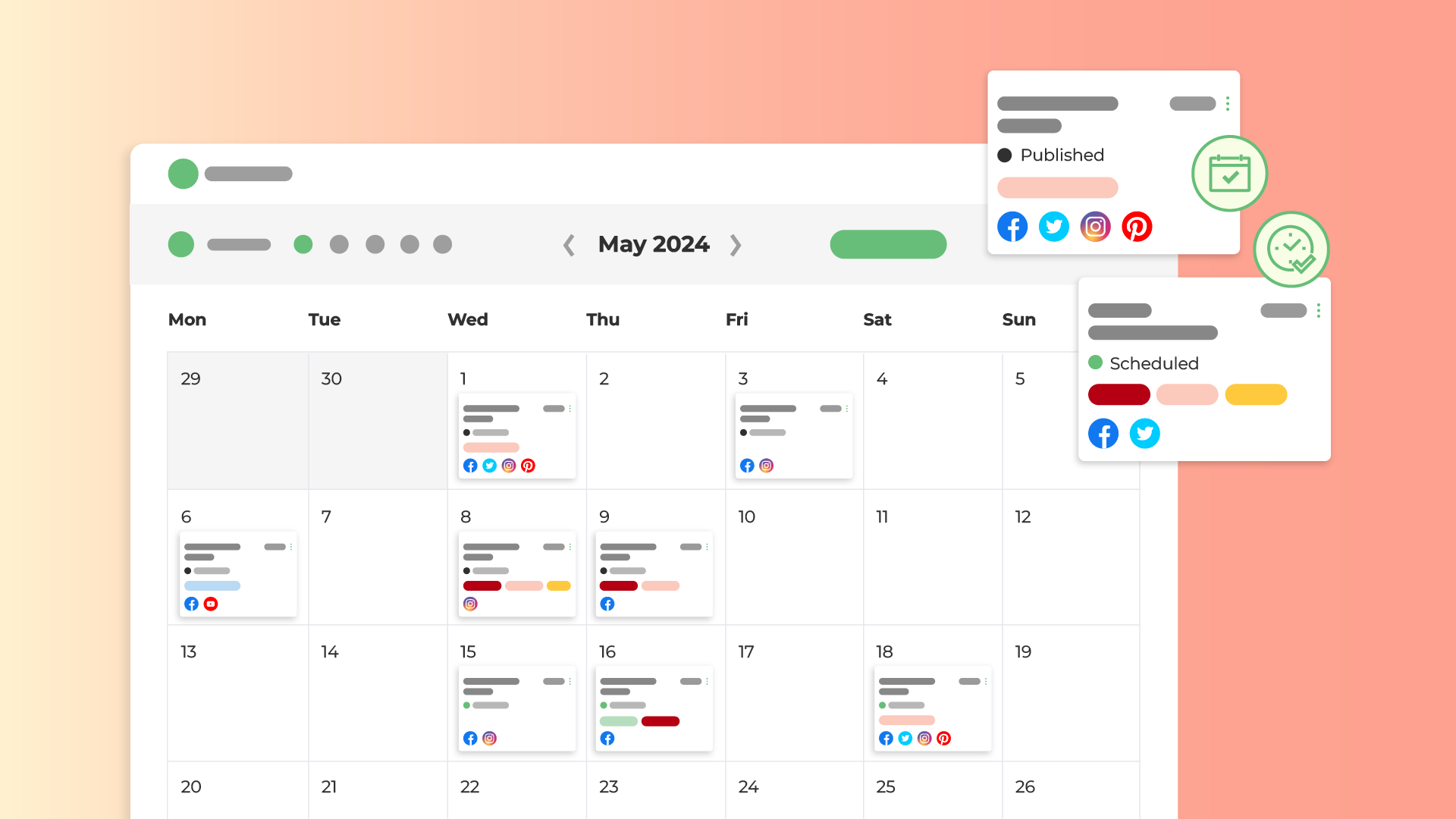Running a single social media campaign is simple and exciting. You map out a few posts in the campaign, and which platforms they’ll appear on. You're off to the races.
But then another campaign comes along. And another. You’ve got multiple post types targeting multiple objectives, with campaigns spanning several months and distinct social media platforms.
We’re speaking from experience here: This type of ad hoc schedule creation quickly becomes chaotic, and many small businesses struggle to keep up with what they’re supposed to post, and when. Things get lost in the shuffle, and great ideas get stuck in a Google sheet where they fade into oblivion.
This is exactly why you need a social media calendar that gives you a bird's eye view of your upcoming schedule alongside detailed views of every planned post. Ideally you can find a calendar that also streamlines all of your social media management processes, like content creation, team and stakeholder collaboration, scheduling, and publication.
In this post, we’ll show you a few different approaches to social media calendars, from the platforms you can use to the ways you can organize your content. We'll also look at a few social media calendar examples so you can choose the optimal way to plan content for your own business.
Do I really need a social media calendar?
If you’re reading this, the short answer is yes, you definitely need a social media calendar.
And here’s why: Social media management has a lot of moving pieces, and a social media calendar is the linchpin. Without a clear social calendar that you can easily read and understand at a glance, things will be missed.
Posts will be forgotten. Team deadlines will fly by. Content will be scheduled for the wrong dates. Work will be duplicated.
It’s also much harder to track campaigns successfully when you aren’t using a visual social media calendar, ensuring that they’re spaced out correctly and going live at optimal times. Social media is a team sport with many players, and using a streamlined social media calendar can keep everyone on the same page and help you know what’s being published.
How to organize content calendar creation
There are different ways to organize content calendars. The most popular examples include sorting or organizing content in a few different ways.
Organize by post type
The first option is to organize your calendar by post type. You likely have evergreen content, standard image posts, product announcement posts, engagement-focused posts, and holiday or seasonal posts. This makes it easy for you to create a balanced calendar with multiple types of posts.
Organize by campaigns
Another option is to organize your calendar by individual campaigns. Campaigns are sets of posts for dedicated business or marketing objectives. A local ice cream shop, for example, may have distinct campaigns to promote brand awareness, increase attendance at a pop-up event, or boost catering bookings.
Organize by channel
The third common option is to organize your content calendar by social media channel. You may view your Facebook campaigns separately from TikTok, for example. Some businesses even separate unique post formats, like Instagram Reels or Stories, from their standard channel posts.
There’s no one right answer here. Many businesses may benefit from organizing content by post type or campaign, as it ensures that key content is created for all relevant channels.
In some cases, using a calendar-view social media scheduler that leverages labels and color-coding can be an invaluable asset, allowing you to easily view all post types across all channels in a single dashboard. Sometimes you want to know how many posts are planned for Instagram. The next day, you need to see if a specific campaign is scheduled correctly. And the week after that you're wondering if you've posted enough TikToks lately. Having powerful post filtering options means one calendar works across every stage of social media marketing.
What should a social media calendar include?
Social media content calendars should always include the following information about each post you create:
- Type of post, or post format
- Campaign categorization
- Post copy
- Post image or video file (including multiple options for different platforms if needed)
- Platforms where post is scheduled
- Publication date and time
This is information you want to see at a glance. These upfront details ensure that you have strong timing for multiple campaign options, that you’re creating a diverse and engaging calendar, and that you know exactly what will be posted when.
Along the same lines, there are a few things you don’t need to worry about seeing at a glance, even if it’s good information to have overall. These include the following:
- Whether or not the content is a repost
- Which team member created the post
- When the post itself was created or uploaded
What does a social media calendar look like?
Social media calendars can come in all different formats.
You can have something as simple as a Google Sheet, which has a list of posts belonging to specific campaigns, the names of platforms, and the dates when they’ll be posted. It may look something like this:
 A simple social media calendar made with Google Sheets
A simple social media calendar made with Google Sheets
Other businesses might use the project management software they’re already using. They may create cards or tasks for individual posts or specific campaigns, which track subtask completion like copywriting, graphic upload, manager approval, and publication. The project management platform monday.com shared this example:
 A basic social media calendar built using project management tool monday.com
A basic social media calendar built using project management tool monday.com
Then there are the dedicated social media scheduling tools that allow you to create posts, schedule them onto a calendar, and add color-coded labels or tags to improve organization. For example, you can create different color-coded labels to quickly identify the types of post or campaign when viewing your calendar in Loomly:
 Loomly's social media calendar also operates as a scheduling, publishing, and analytics tool
Loomly's social media calendar also operates as a scheduling, publishing, and analytics tool
Social media calendar tools typically allow you to view different timelines, including daily, weekly, and monthly views. These timeline views can help you get both big-picture views so that you can monitor posting cadence and overall scope while also assessing the day-to-day details like exact posting times across different channels at a granular level.
When it comes to content calendar creation, some brands may use a combination of tools. Let’s look at an example.
When working with her clients, freelance social media and content marketer Ana Gotter starts by sending a list of specific posts she’ll create for the month in a Google Doc. The posts are grouped by campaign type. After clients approve the types of posts on a strategic level, she’ll create the posts in the client’s chosen social media calendar tool. There, the client can approve them and schedule them for publication.
You can shave precious time off this process with social media scheduling tools that have collaboration built in. In Loomly, you can draft posts and then create a custom approval workflow to have them reviewed and greenlit by your clients or your team. Skip the software switching by picking a social media tool with both calendar functionality and collaboration tools. Then you can take care of planning, creating, scheduling, and analyzing content in one place.
Best practices for organizing your social media calendar
When creating and organizing your social media content calendar, there are a few best practices to keep in mind:
- Choose a method that works for you. You may use multiple tools for content creation and calendar visualization, or you might prefer a single, all-in-one option. Consider your workflows and approval processes, and look at ways to streamline it.
- Opt for a visual tool with a calendar view. Most brands benefit significantly from clear calendar view that lays out their entire schedule. You can easily see what’s being posted, and many tools like Loomly have drag-and-drop features for easy reorganization as needed.
- Take advantage of all categorization features. Some social media scheduling tools allow you to give posts a name, like “Pop-Up Announcement,” or “Brand Awareness.” Others may allow you to add color-coded labels that can help you track post categorization or campaign types. These organizational features can be invaluable.
- Customize your posts. This is coming from a content creation standpoint, but we can’t stress it enough. Social media calendar tools often allow you to publish directly to the platforms themselves. Make sure that each post is customized to match the platforms’ specifications and best practices. For example, in Loomly you can remix a single image for every social platform's dimensions, and create corresponding captions for each.
Let's look at this social media calendar best practices in action.
Plant with Purpose is a California-based nonprofit that seeks to promote local ecosystems and communities. They had previously relied on a manual system that involved folders for graphics and a Google Sheet with copy and slots to input analytics. They switched to Loomly for a more streamlined process.
After switching to Loomly, their social media calendar got a lot more organized. They took advantage of the tool's ability to create a single post and then customize the format, copy, and publication dates for each social channel. They gave each post an easy-to-track title, helping them nail the right campaign posting cadence and review analytic data effortlessly.
 Non-profit Plant with Purpose uses Loomly to manage their social media presence
Non-profit Plant with Purpose uses Loomly to manage their social media presence
They also use Loomly’s social calendar features to track post status, including whether it’s a draft, pending approval, requiring edits, scheduled, published, or failed to publish. By assigning posts to specific team members, their internal team collaboration and review processes have never been easier.
Final Thoughts
Every brand’s social media calendar will look a little different, but finding a solution that allows you to review key information at a quick glance is crucial. Whether you plan to scale up over time or are simply looking for a way to better organize and optimize your content now, choosing a dedicated social media calendar tool will often benefit you most in the long run.
Want to learn more about Loomly’s social media calendar tool? Try it free here!



